
Ryde Pier is an early 19th century pier serving the town of Ryde, on the Isle of Wight, off the south coast of England. It is the world's oldest seaside pleasure pier. Ryde Pier Head railway station is at the sea end of the pier, and Ryde Esplanade railway station at the land end, both served by Island Line trains.

Saltburn-by-the-Sea, commonly referred to as Saltburn, is a seaside town in Redcar and Cleveland, North Yorkshire, England, around 12 miles (19 km) south-east of Hartlepool and just under 5 miles (8 km) south-east of Redcar.

Sir Richard Trevithick Tangye was a British manufacturer of engines and other heavy equipment.

Clevedon Pier is a seaside pier in the town of Clevedon, Somerset, England on the east shore of the Severn Estuary. It was described by Sir John Betjeman, as "the most beautiful pier in England" and was designated a Grade I listed building in 2001.

Babbacombe Cliff Railway, also known as the Babbacombe Cliff Lift, is a funicular railway in the town of Torquay in the English county of Devon. It links Babbacombe Downs with Oddicombe Beach. The line formerly ran every day between 09:30 and 17:30, with a closure period in winter for maintenance. A bell is rung 30 and 15 minutes before closing.

North Pier is the most northerly of the three coastal piers in Blackpool, England. Built in the 1860s, it is also the oldest and longest of the three. Although originally intended only as a promenade, competition forced the pier to widen its attractions to include theatres and bars. Unlike Blackpool's other piers, which attracted the working classes with open air dancing and amusements, North Pier catered for the "better-class" market, with orchestra concerts and respectable comedians. Until 2011, it was the only Blackpool pier that consistently charged admission.

The British town of Scarborough has had a total of five cliff railways, or funiculars, two of which are presently operational. The town is home to the first funicular railway in the United Kingdom.
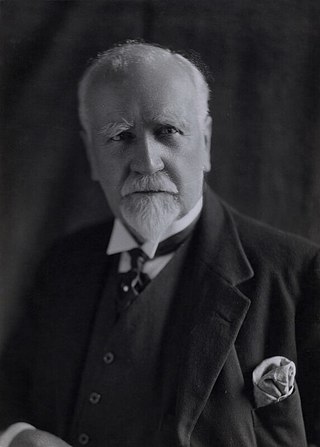
George Croydon Marks, 1st Baron Marks, CBE, known as Sir George Marks between 1911 and 1929, was an English engineer, patent agent and Liberal politician.
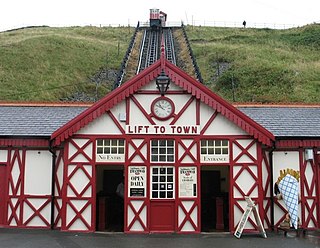
The Saltburn Cliff Lift is a funicular railway in Saltburn-by-the-Sea, Redcar and Cleveland in the ceremonial county of North Yorkshire, England. It provides access to Saltburn Pier and the seafront from the town. The cliff lift is the oldest operating water-balance cliff funicular in the United Kingdom.
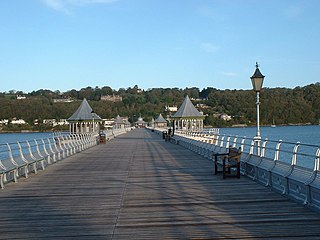
Garth Pier is a Grade II listed structure in Bangor, Wales. At 1,500 feet (460 m) in length, it is the second-longest pier in Wales, and the ninth longest in the British Isles.

Beaumaris Pier is a pier in Beaumaris, Anglesey, North Wales.

Trinity Chain Pier, originally called Trinity Pier of Suspension, was built in Trinity, Edinburgh, Scotland in 1821. The pier was designed by Samuel Brown, a pioneer of chains and suspension bridges. It was intended to serve ferry traffic on the routes between Edinburgh and the smaller ports around the Firth of Forth, and was built during a time of rapid technological advance. It was well used for its original purpose for less than twenty years before traffic was attracted to newly developed nearby ports, and it was mainly used for most of its life for sea bathing. It was destroyed by a storm in 1898; a building at the shore end survives, much reconstructed, as a pub and restaurant called the Old Chain Pier.

Withernsea Pier was a pier in the town of Withernsea, East Riding of Yorkshire, England. The pier was constructed between 1875 and 1877 to attract daytrippers, but was beset by accidents from the outset. Storms and ship-caused damage led to the pier being closed by 1893, and it was completely dismantled by 1903, leaving only the distinctive castellated pier towers on the seafront, which are still there to this day.
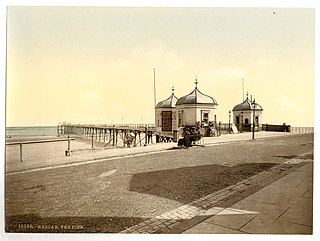
Redcar Pier was a Victorian pleasure and landing pier constructed on The Esplanade in the seaside town of Redcar on the north east coast of Yorkshire, England.

Coatham Pier or Victoria Pier, Coatham, was a pleasure pier built on Newcomen Terrace in the Coatham area of Redcar on the north-east Yorkshire coast.

West End Pier was one of two piers in Morecambe, Lancashire, England, built during the late 19th century to an eventual length of 1,800 feet (550 m) long and officially opened on 3 April 1896 by Colonel William Henry Foster MP. The pier was one of the first structures in the town to be installed with electric lighting in 1899.
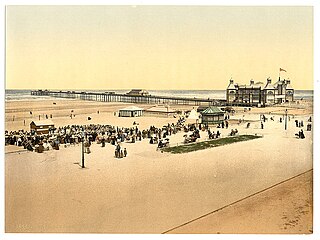
Rhyl Pier, officially known as the Victoria Pier, was a pleasure pier in the seaside town of Rhyl, Flintshire, and the first to be built in North Wales. Designed by James Brunlees and opened in August 1867 at a length of 2,355 feet (718 m), it was the town's central attraction for the ensuing years. Following dispute and public consultation regarding the location it would be built, the pier was constructed near the centre of the esplanade. The pier's Grand Pavilion, built in 1891, featured the world's largest organ, known as the Grand Jubilee Organ and weighed 25 tonnes.
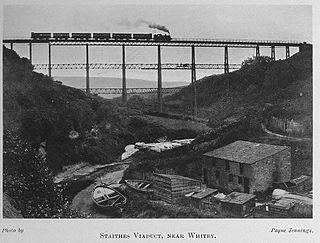
Staithes Viaduct was a railway bridge that straddled Staithes Beck at Staithes, Yorkshire, England. It was north of the closed Staithes railway station. It was known for an anemometer, a fitting to tell the signaller if winds across the viaduct were too strong for crossing trains.
Scarborough North Pier (1868-1905) was a steamer and promenade pier in North Bay, Scarborough, North Yorkshire, England.

Kilton Viaduct was a railway viaduct that straddled Kilton Beck, near to Loftus, in North Yorkshire, England. The viaduct was opened to traffic in 1867, however in 1911, with the viaduct suffering subsidence from the nearby ironstone mining, the whole structure was encased in waste material from the mines creating an embankment which re-opened fully to traffic in 1913. The railway closed in 1963, but then in 1974, it re-opened as part of the freight line to Boulby Mine carrying potash traffic.




















